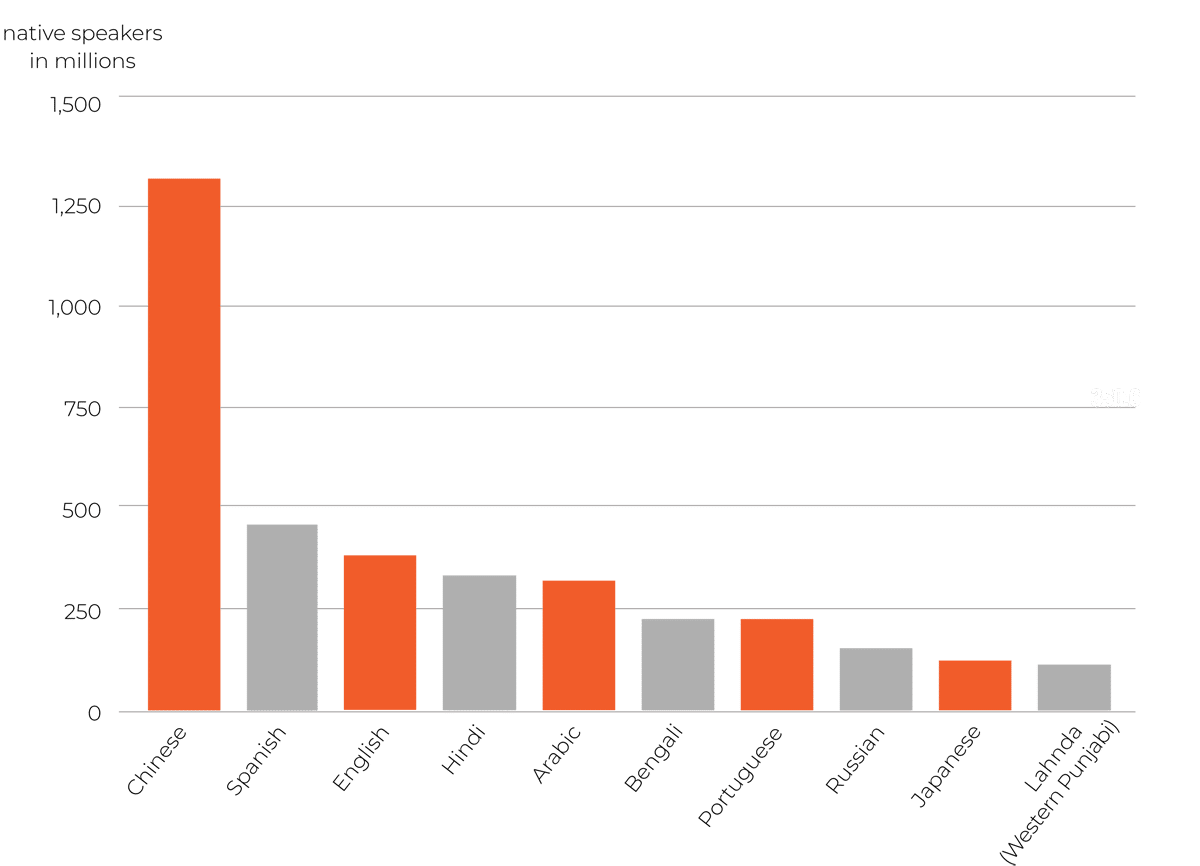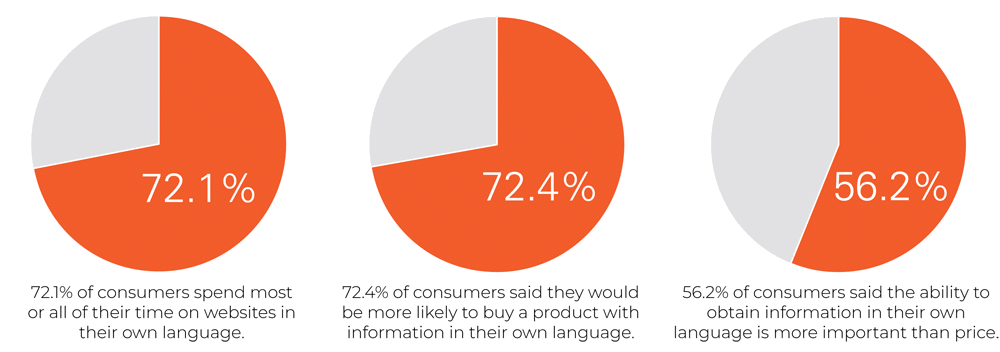Top 3 Competitive Advantages of Website Localization
As society becomes increasingly more diverse, whether to translate your digital presence merits hard consideration. Is translation a good investment? What are the advantages? Does website localization really increase traffic and convert prospects into clients?
The Competitive Advantages of Website Localization
While English has been the language of business for a long time, new markets are developing and with them come new opportunities. Companies willing to translate have a number of advantages over their competitors.
Growth. Website translation opens up huge opportunities for growth. Companies that add multilingual versions of their websites increase their marketability and take advantage of rapidly growing markets to reach new prospects.
Brand identity. A focused localization strategy tailored to the preferences of specific locales positions a company to increase brand recognition.
Retention. Ongoing support and documentation in clients’ own languages strengthens relationships and creates brand advocates.
National and International Growth Potential
Website localization can significantly improve a company’s reach. The opportunity is there, both on a domestic and international scale.
Domestic Markets
Millions of people in the U.S. don’t speak English, and the percentage of non-English speakers has been on the rise for decades. More than 20% of US residents speak a language other than English at home. In real numbers, this means that 66.6 million Americans have a preferred language that is not English. This number has doubled since 1990 and tripled since 19801.
With over 40 million speakers, Spanish is the most widely-spoken language in the U.S. outside of English. Next is Chinese with 3.5 million speakers, followed by Tagalog, Vietnamese, Arabic, French, and Korean, each of which is spoken by over a million U.S. residents.
International Opportunities
We live in a linguistically diverse world. While it is estimated that over 7,000 languages are spoken across the globe, more than half of the world’s population speak just 23 languages2.
Chinese is the most popular language worldwide, with approximately 1.3 billion native speakers. Spanish, spoken by 460 million, is next followed by English with 379 million.
Most spoken languages worldwide:
While it is clearly not the most widely spoken language, English has dominated the internet since its launch. However, that dynamic is changing, as different nations gain greater prominence in the global economy and new countries come online.
One revelatory fact is that worldwide, about 70% of internet users are non-native English speakers, yet over 50% of global internet content is in English. This gap between English-language content and English-language speakers presents huge opportunities for companies willing to invest in multilingual websites.
How Translation Impacts Buying Habits
Language matters—just consider how it impacts consumers. The research and analysis firm Common Sense Advisory polled over 3,000 consumers in 10 countries to analyze the degree to which language impacts buying habits. The study revealed (unsurprisingly) that people have a strong preference for their mother tongue. Prospects who are not strong English speakers spend less time on English-language websites during their visits and/or avoid them altogether. Non-English speakers are also less likely to buy products that lack instructions or customer support in their language. Ultimately, the more local-language content available throughout the customer journey, the greater the likelihood of purchase.
Simply put, people prefer to be spoken to in their preferred language.
Source: CSA Research4
Get in Touch!
Reach out to discuss your next translation project with a member of our team.
Website Localization Helps Companies Maintain a Competitive Advantage
To take advantage of the opportunities the online language gap presents, a website and its messaging must appeal to the people living in specific locales. This appeal entails localization.
Localization is the process of adapting content to a distinct locale or market. A localized website takes on the look and feel of a local company, making it relatable.
In addition to translation, localization entails
- Adapting layout, graphics, and images to the preferences of the target market.
- Converting to local date, time, and measurement conventions.
- Adjusting design and layout to display translated text properly.
A properly localized website conveys customized messaging to the target culture. While website localization may seem like an expensive and time-consuming task, it doesn’t need to be an all-or-nothing undertaking. If a company is not prepared to localize all of its content, it can optimize the highest-performing pages. Better still, it can focus on pages that directly relate to its core offerings and those that are most relevant to the local audience.
Translation Leads to Stronger Brand Recognition
A company’s brand identity reflects the personality of the business and its promise to its customers. A brand reflects who a company is, who it wants to be, and who people perceive it to be. And this identity expresses itself through language as well as visuals.
When evaluating the impact your brand has with non-English speakers, consider:
- How do people in my target locales view my company?
- How could this approach be improved by adapting to their needs and preferences?
- How can I excite these specific target markets about my brand?
When targeting different languages and cultures, avoid a one-size-fits-all branding strategy. Your messaging should be adapted to the different locales you are targeting, while at the same time maintain a coherent identity across cultures.
Proper localization gives a company control over its brand messaging and ensures that all cultural considerations have been considered. For example, it’s important to make sure your brand name, taglines, and product names don’t have negative connotations in your target markets. Consider how edgy brand names such as Urban Decay cosmetics or Poison perfume may not resonate well in some conservative cultures. One great example of a brand name that got lost in translation is Irish Mist whiskey. The product was not well received in Germany where “mist” is the German word for manure.
Featured Services
Learn more about…
How Translation Helps Retain Business
A new customer costs five times more to acquire than retaining an existing one. Don’t lose focus on your existing customers—keep them happy and make them your advocates.
Everyone wants to feel that the company they do business with listens and responds to their needs. For companies with multilingual customers, translating support materials, product manuals, and online assistance maintains these customers’ loyalty. Translation also clarifies communication when clients reach out for ongoing support. Ultimately, the personal approach to customer service differentiates a brand and builds committed customers who become brand champions.
Establish a Strong Voice in New Markets
As stated by Willy Brandt, former German Chancellor, “If I’m selling to you, I speak your language. But if I’m buying, dann müssen Sie Deutsch sprechen (then you have to speak German).5”
Language is a competitive advantage. By presenting your company’s offerings in your target customers’ preferred languages, you increase your ability to establish genuine connections and present compelling reasons to try your products and services. You build a stronger, more memorable brand. And you establish yourself as a go-to provider for new prospects and existing clients alike.
 Named to the 2024 Inc. 5000 list of fastest-growing companies and ranked among the world’s top 100 language service providers by CSA Research
Named to the 2024 Inc. 5000 list of fastest-growing companies and ranked among the world’s top 100 language service providers by CSA Research



